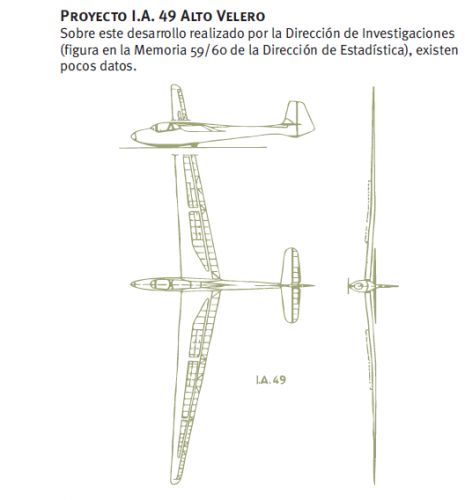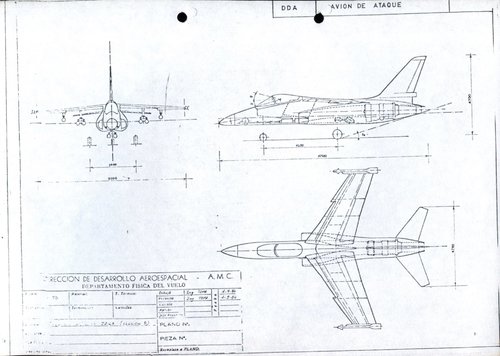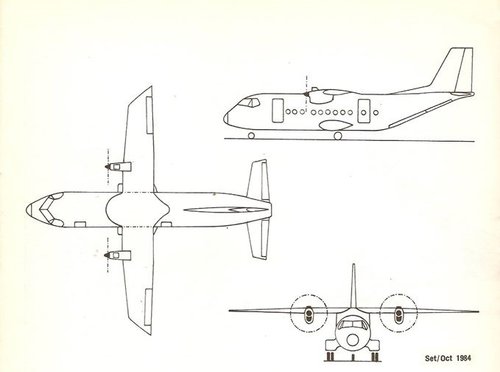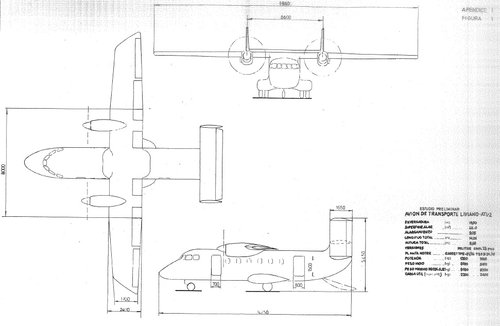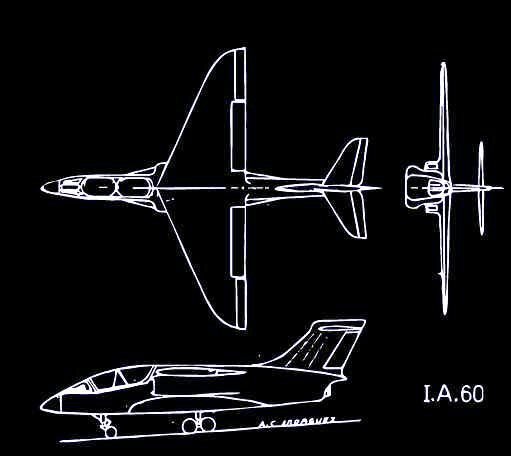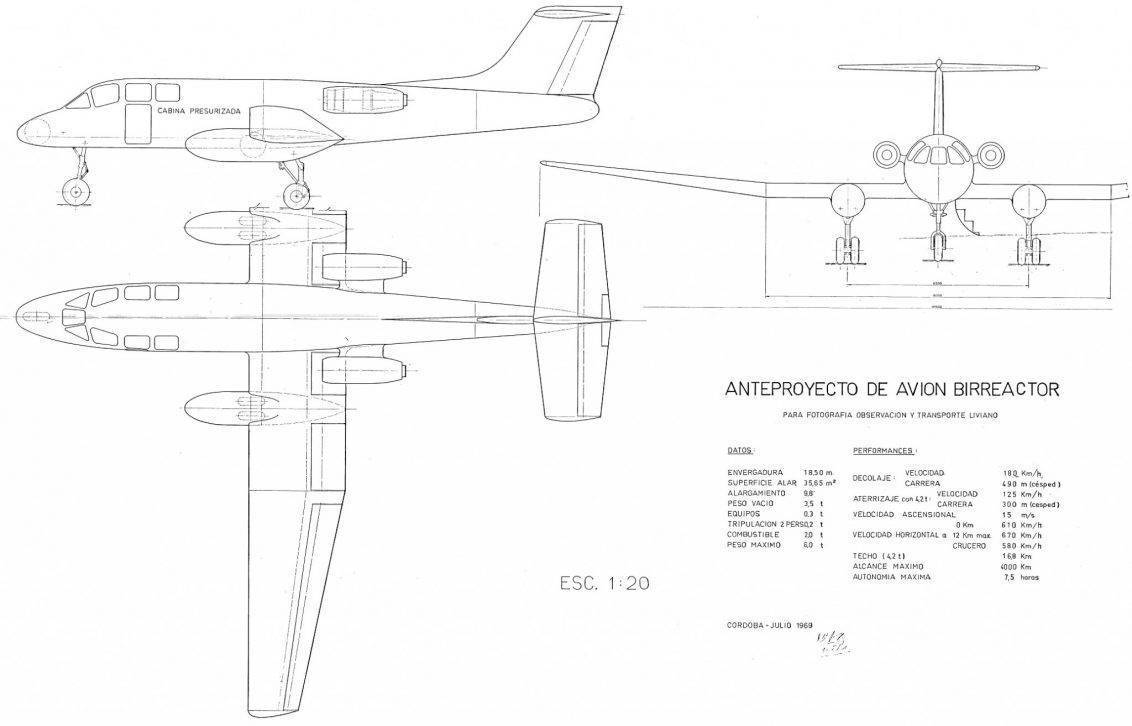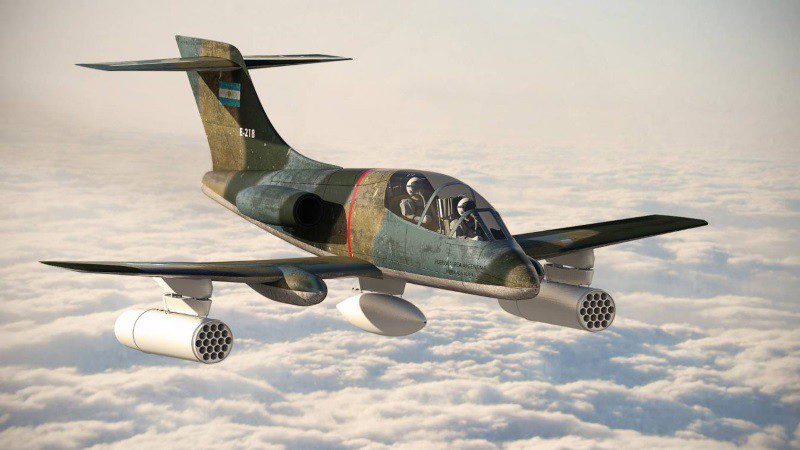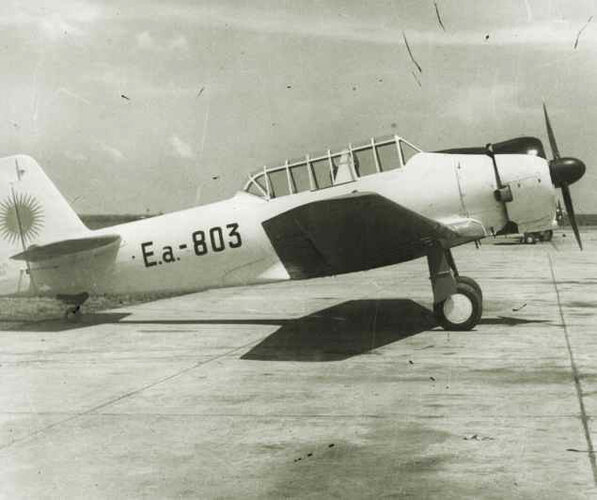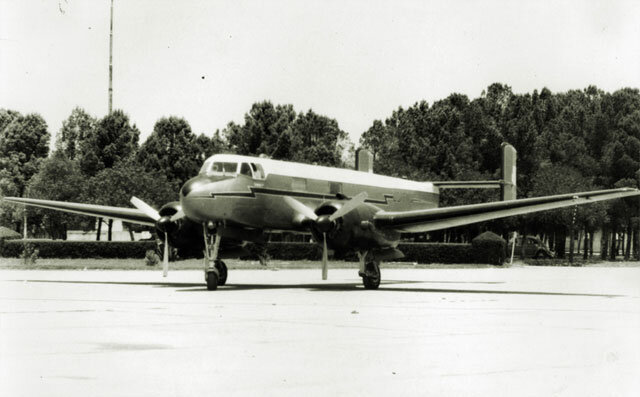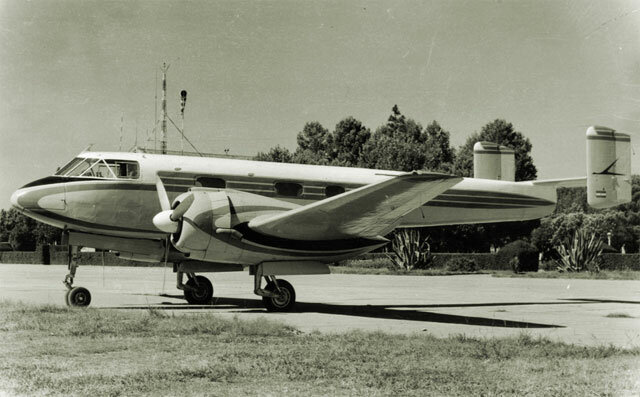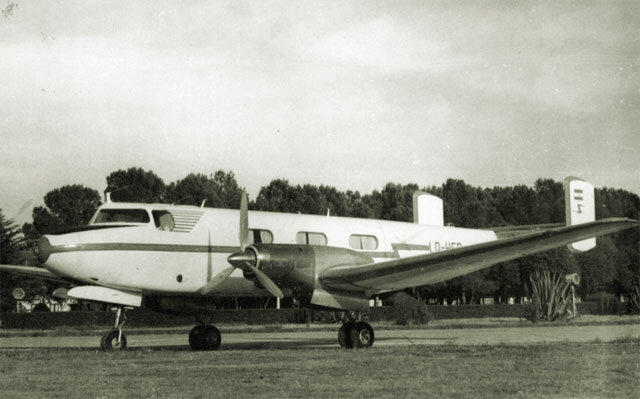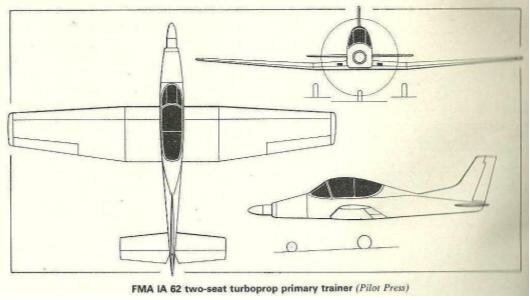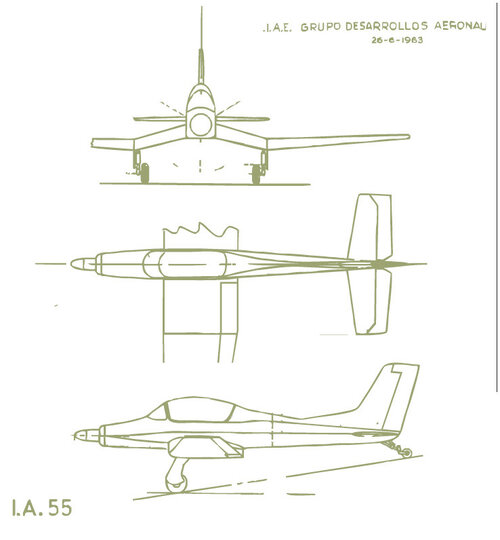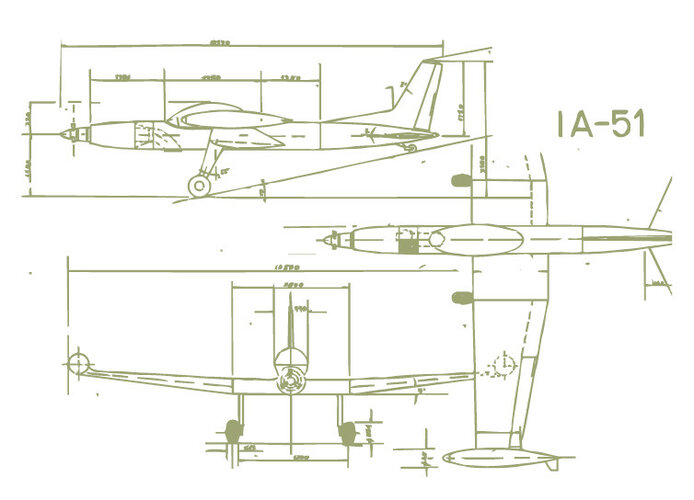- Joined
- 25 June 2009
- Messages
- 13,941
- Reaction score
- 3,574
We have topics on several of the aircraft in this list, and attempts at identifying missing numbers in places, but no complete list in one single topic, so I thought this could be a good idea. Since it's the "Designations" section here, I'm only giving the basic info for identification purposes, but it's always possible to develop one or several projects in the appropriate section.
The history of Argentine aircraft production is very complicated to understand because of the way the official engineering and production entities have been renamed, taken over, merged, even sold, over the years. The Fábrica Militar de Aviones (FMA) was created in 1927, and produced all aircraft from then onwards. The Instituto Aerotécnico (Institec) was created in 1943 as a development unit, and in 1944, FMA became a division of Institec. As a result, all the aircraft projects carried "I.Ae." designations. In 1951, Industrias Aeronáuticas y Mecánicas del Estado (IAME) was created, and both Institec and FMA became a part of it. In 1957, the aviation activity of IAME became DINFIA (Dirección Nacional de Fabricaciones e Investigaciones Aeronáuticas), which lasted until 1967, when it became AMC (Área Material Córdoba). Although Institec still existed as a separate entity until 2009, the Fábrica Militar de Aviones (FMA), now as a division of AMC, lasted until 1995, when aircraft production was sold to Lockheed Martin to become Lockheed Martin Aircraft Argentina S.A. (LMAASA). In 2009, Lockheed Martin sold it back to Argentina, and it became the Fábrica Argentina de Aviones « Brigadier San Martín » S.A. (FAdeA). Have I lost you along the way? You're excused, it's all such a complicated mess!
General information on the FMA and FAdeA can be found in these English and Spanish language Wikipedia pages:
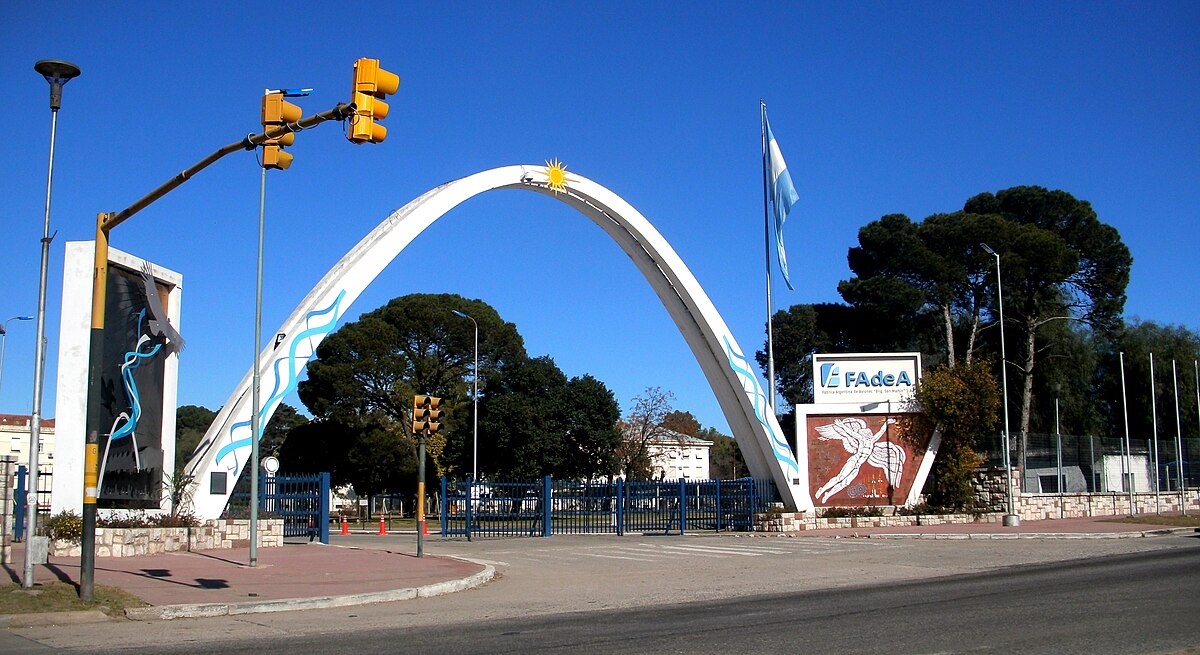
 en.wikipedia.org
en.wikipedia.org

 es.wikipedia.org
es.wikipedia.org
Early license-built types
NOTES:
- A "Tipo El Palomar" replica was produced by DINFIA in 1962.
- The Fw 44J sometimes appears as the "Jilguero", although it seems to be a translation of "Stieglitz" and not an official name.
Early Argentine types (Ae. series)
Early Argentine types (I.Ae. designations)
NOTES:
- The only known designations before the "20" slot are those given to two locally developed engines: El Gaucho (I.Ae. 16) and El Indio (R-19/-19R/-19 SR/1 A, R-19 CR/1 C, and R-19 CR/2). There is no indication that there ever were other numbers allocated to any other designs or projects, although it is possible that the early "Ae." aircraft may have been given such numbers internally.
- Only the designs that were built are in bold type.
Types developed under I.A.M.E. (I.A. designations)
NOTES:
- Reimar Horten also developed a series of glider and sailplane designs in 1952 designated INAV-1A to -1E. Only the first one was built, but it was an independent development, not under FMA.
- An air-to-surface missile designated PAT-1 (Proyectil Argentino Teledirigido 1) was continued from a Nazi project, built and test-flown. The PAT-2 surface-to-surface missile was continued from the Nazi V-1 design, but never built. Both were canceled for technical, budgetary and safety reasons.
Types developed under DINFIA (I.A. designations)
The Pucará
Later types (IA- designations)
Other license-built types
NOTES:
- Israel-based company I.A.I. delivered its own versions of the French Mirage V to Argentina: 32 examples of the M-5 Dagger (single-seat fighters)and four M-5 Dagger T (two-seat trainers) in 1978, and one M-5 Finger IA in 1981 (a modernized version). Further versions were developed locally by AMACUAR/Aerocuar throughout the 1980s, and designated M-5 Finger IIA, Finger IIIA, Finger IIIB and M-5P Mara. They were modified from the earlier production.
The history of Argentine aircraft production is very complicated to understand because of the way the official engineering and production entities have been renamed, taken over, merged, even sold, over the years. The Fábrica Militar de Aviones (FMA) was created in 1927, and produced all aircraft from then onwards. The Instituto Aerotécnico (Institec) was created in 1943 as a development unit, and in 1944, FMA became a division of Institec. As a result, all the aircraft projects carried "I.Ae." designations. In 1951, Industrias Aeronáuticas y Mecánicas del Estado (IAME) was created, and both Institec and FMA became a part of it. In 1957, the aviation activity of IAME became DINFIA (Dirección Nacional de Fabricaciones e Investigaciones Aeronáuticas), which lasted until 1967, when it became AMC (Área Material Córdoba). Although Institec still existed as a separate entity until 2009, the Fábrica Militar de Aviones (FMA), now as a division of AMC, lasted until 1995, when aircraft production was sold to Lockheed Martin to become Lockheed Martin Aircraft Argentina S.A. (LMAASA). In 2009, Lockheed Martin sold it back to Argentina, and it became the Fábrica Argentina de Aviones « Brigadier San Martín » S.A. (FAdeA). Have I lost you along the way? You're excused, it's all such a complicated mess!
General information on the FMA and FAdeA can be found in these English and Spanish language Wikipedia pages:

Fábrica Argentina de Aviones - Wikipedia

Fábrica Argentina de Aviones - Wikipedia, la enciclopedia libre
Early license-built types
| Tipo El Palomar (H. Farman) | EAM | Development of 50hp Henri Farman type | 1914 | 5 built |
| Maurice Farman, modificado | ANRP | Revised version of 70hp Maurice Farman type | 3 built | |
| 504K Gosport (Avro) | FMA | License-built biplane basic trainer | 1928 | 31 built |
| F.2B Fighter (Bristol) | EAM/FMA | License-built biplane fighter; rebuilt examples | 1929 | 10 built |
| D.21 (Dewoitine) | FMA | License-built single-seat fighter | 1930 | 35 built |
| Rhön Bussard (DFS) | FMA | License-built single-seat glider | circa 1935 | 4 built |
| Hawk 75O (Curtiss) | FMA | License-built monoplane fighter | 1940 | 20 built |
| Fw 44J Stieglitz (Focke-Wulf) | FMA | License-built biplane trainer | 1940 | 190 built |
- A "Tipo El Palomar" replica was produced by DINFIA in 1962.
- The Fw 44J sometimes appears as the "Jilguero", although it seems to be a translation of "Stieglitz" and not an official name.
Early Argentine types (Ae. series)
| Ae.C.1 | FMA | Civil tourism aircraft prototype (initial version); basic trainer (later version); first local design | 1931 | 1 built |
| Ae.M.E.1 | FMA | Tandem-seat low-wing single-engine primary trainer | 1932 | 7 built |
| Ae.C.2 Tenga Confianza | FMA | Tandem-seat low-wing single-engine civil/tourism aircraft, a version of Ae.M.E.1 | 1932 | 2 built |
| Ae.T.1 | FMA | Low-wing single-engine transport/commercial aircraft | 1933 | 3 built |
| Ae.C.3 | FMA | Low-wing single-engine civil aircraft | 1934 | 16 built |
| Ae.M.O.1 Tronco | FMA | Observation monoplane | 1934 | 41 built |
| Ae.M.Oe.1 Tronco | FMA | Observation and training aircraft, a variant of Ae.M.O.1 | 1934 | 6 built |
| Ae.M.Oe.2 Tronco | FMA | Observation and training aircraft, a variant of Ae.M.Oe.1 | 1934 | 61 built |
| Ae.M.S.1 | FMA | Sanitary aircraft | 1935 | 1 built |
| Ae.M.B.1 | FMA | Low-wing single-engine cantilever monoplane bomber; first bomber built by FMA | 1935 | 1 built |
| Ae.M.B.2 Bombi | FMA | Low-wing single-engine cantilever monoplane bomber | 1935 | 14 built |
| Ae.C.3G | FMA | Low-wing single-engine tourism aircraft | 1936 | 1 built |
| Ae.C.4 | FMA | Improved prototype version of the Ae.C.3G | 1936 | 1 built |
Early Argentine types (I.Ae. designations)
| FMA-20 El Boyero | Petrolini (FMA) | Two-seat tourism aircraft with 65hp Continental A-65-8 engine | 1940 | 130 built by Industrias Petrolini | |
| I.Ae.20-B El Boyero | Petrolini (FMA) | Variant with 75hp Continental A-75 engine | (see above) | ||
| FMA-21 | FMA | Advanced trainer prototype based on North American NA-16-1P fuselage | 1943 | 1 built | |
| I.Ae.22 DL | I.Ae./FMA | Advanced trainer aircraft | 1943 | 206 built | |
| I.Ae.22-C DL (= DL-22C) | I.Ae./FMA | Version with 475hp Armstrong Siddeley Cheetah engine and two-blade constant-speed Rotol propeller | (100 included in above) | ||
| I.Ae.23 "Focke-Wulf de Madera" | I.Ae./FMA | Basic trainer prototype based on Focke-Wulf Fw 44J | 1945 | 1 built | |
| I.Ae.24 Calquín | I.Ae./FMA | Two-seat attack/light bomber | 1946 | 100 built | |
| I.Ae.25 Mañque | I.Ae./FMA | Assault/troop transport glider for three paratroopers | 1945 | 1 built | |
| I.Ae.26 (= D.600) | I.Ae./Dewavion | Single-engine conventional fighter aircraft designed by Emile Dewoitine; superseded by I.Ae. 27 | not built | ||
| I.Ae.27 Pulqui (= D.700) | I.Ae./Dewavion/FMA | Jet fighter prototype, first such in Latin America, designed by Dewoitine | 1947 | 1 built | |
| I.Ae.27A/B Pulqui II | I.Ae. | Projected development by Morchio and Riccardi, competing with I.Ae.33 | circa 1948 | not built | |
| I.Ae.28 Super Calquín | I.Ae. | Twin-engine light attack bomber with R-R Merlin III engines, abandoned in favour of I.Ae. 30 Ñancú | circa 1947 | not built | |
| I.Ae.28 (=D.710) | I.Ae./Dewavion | Twin-engine eight-passenger transport project | 1947 | not built | |
| I.Ae.29 (= D.720) | I.Ae./Dewavion | Single-seat jet fighter project with straight wings, lower nose intakes; abandoned with development of I.Ae.33 | 1947-48 | not built | |
| I.Ae.30 Ñamcú | I.Ae./FMA | Twin-engine fighter/attack prototype | 1947-48 | 1 built | |
| I.Ae.30-B Ñamcú | I.Ae. | Tandem-seat fighter/trainer version | 1948 | not built | |
| I.Ae.30 "Pallavicino I" | I.Ae. | Projected heavy fighter twin-jet development by Italian engineer | 1949 | not built | |
| I.Ae.30 "Pallavicino II" | I.Ae. | Projected light-bomber twin-jet development by Italian engineer | 1949 | not built | |
| I.Ae.31 Colibrí | I.Ae./FMA | Tandem-seat enclosed primary trainer/aerobatics aircraft | 1946-47 | 3 built | |
| I.Ae.32 Chingolo | I.Ae./FMA | Tourism/trainer/aerobatics aircraft | 1949 | 1 built | |
| I.Ae.33 | I.Ae./FMA | Full-scale glider demonstrator | 1949 | 1 built | |
| I.Ae.33 Pulqui II | I.Ae./FMA | Swept-wing supersonic jet fighter designed by Kurt Tank | 1950 | 4 built (+1 built from parts of others) | |
| Expediente S339/49 ('Caza sin cola') |
| Single-seat tailless flying-wing fighter project by Reimar Horten | |||
| I.Ae. 34 Clen Antú (= H XVa) | I.Ae./FMA | Flying wing glider designed by Horten | 1949 | 3 built | |
| I.Ae.34-B Clen Antú | I.Ae./FMA | Modified version for testing of unconventional control surfaces | 1949 | 1 built | |
| I.Ae.34-M Clen Antú (= H XVb) | I.Ae./FMA | Single-seat version | 1951 | 2 built |
- The only known designations before the "20" slot are those given to two locally developed engines: El Gaucho (I.Ae. 16) and El Indio (R-19/-19R/-19 SR/1 A, R-19 CR/1 C, and R-19 CR/2). There is no indication that there ever were other numbers allocated to any other designs or projects, although it is possible that the early "Ae." aircraft may have been given such numbers internally.
- Only the designs that were built are in bold type.
Types developed under I.A.M.E. (I.A. designations)
| I.A. 35 "Justicialista del Aire" | IAME | Twin-engined general-purpose monoplane prototypes | 1953 | 2 built |
| I.A.35 Type 1A Huanquero | IAME | Advanced instrument or navigation trainer | 1957 | 1 built |
| I.A.35 Type 1B Huanquero | IAME | Bomber version of Type 1A | 1957 | 1 built |
| I.A.35 Type 1U Huanquero | IAME | Bombing and gunnery trainer | 1957 | 1 built |
| I.A.35 Type II Huanquero | IAME | Light transport/liaison version | 1958 | 20 built |
| I.A.35 Type III Huanquero | IAME | Air ambulance version with a crew of three and four stretchers with attendants | circa 1958 | 5 built |
| I.A.35 Type IV Huanquero | IAME | Photographic reconnaissance version with crew of three and camera operator | circa 1959 | 9 built |
| I.A.35 Type V (?) Constancia | IAME | Executive transport version with crew of three and seven passengers | 1957 | 1 built |
| I.A.35-X-III Pandora | IAME | Executive transport version with room for ten passengers | 1960 | 1 built |
| I.A.35 Guaraní (I) (ex-Constancia II) | DINFIA | Transport derivative with Turbomeca Bastan turboprops | circa 1960 | 1 built |
| I.Ae. 36 Cóndor II (Pentaturbo) | IAME | Jet airliner project for 35 passengers, designed by Kurt Tank | 1951 | not built |
| I.A.37-P "Ala Delta" | IAME | Delta wing glider designed by Reimar Horten as prototype for interceptor | 1954 | 1 built |
| I.A.37-E | IAME | Planned jet trainer version | 1954 | not built |
| I.A.38 "Naranjero" | IAME | Four-engine experimental flying-wing cargo transport designed under Reimar Horten, based on H VIII | 1959-60 | 1 built |
| I.A.39 | IAME | Twin-engine twin-fin short-haul airliner based on I.Ae. 35 airframe | 1954 | not built |
| I.A.40 | IAME | Night fighter project, no data | 1956 | not built |
| I.Ae.41 (I.A.41-L) Urubú (= H XVc) | IAME | Flying-wing glider designed by Reimar Horten, a development of I.A.34 | 1950-53 | 4 built |
| "Ala Delta" | IAME | Single-seat jet powered delta wing project designed by Reimar Horten | 1952 | not built |
| I.Ae.42 | IAME | Four-engine passenger transport project | 1952-56 | not built |
| I.Ae.43 | IAME | Four-seat delta-wing project | 1953-54 | not built |
| Pulqui III (I.A.40 ? I.A.43 ?) | IAME | Single-seat swept-wing supersonic delta-wing hunter-interceptor project designed by Kurt Tank; basis for HF-24 Marut in India | 1954-57 | not built |
| I.A.44 DL II (Super DL) | IAME | Tandem-seat enclosed advanced trainer project | 1953 | not built |
| I.A.45 Querandí | IAME > DINFIA | Light executive transport for five passengers | 1957-59 | 2 built |
- Reimar Horten also developed a series of glider and sailplane designs in 1952 designated INAV-1A to -1E. Only the first one was built, but it was an independent development, not under FMA.
- An air-to-surface missile designated PAT-1 (Proyectil Argentino Teledirigido 1) was continued from a Nazi project, built and test-flown. The PAT-2 surface-to-surface missile was continued from the Nazi V-1 design, but never built. Both were canceled for technical, budgetary and safety reasons.
Types developed under DINFIA (I.A. designations)
| I.A.46 Ranquel | DINFIA | High-wing trainer/agricultural aircraft with 150hp Lycoming O-320-A2B engine | 1957 | 101 built (or 116 ?) |
| I.A.46 Súper Ranquel | DINFIA | More powerful version with 180hp Lycoming O-360-A1A engine | 1958 | 116 built (or 16 ?) |
| I.A.47 | DINFIA | Twin-engine passenger transport project with two 2504 hp R-R Dart RDA.8 engines | 1957 | not built |
| I.A.48 "Ala Delta Ovoidal" | DINFIA | Cancelled twin-engine supersonic ovoid delta-wing all-weather recce interceptor | 1954-1959 | not built |
| I.A.49 "Alto Velero" | DINFIA | Projected sailplane designed by Reimar Horten to study laminar flow | late 1950s | not built |
| I.A.50 (1) | DINFIA | Eight-passenger executive transport project | not built | |
| I.A.50 Guaraní II (I.A.50 G II) | DINFIA | Twin-engine multipurpose aircraft | 1962-63 | 34 built |
| I.A.50 Guaraní II | DINFIA | Antisubmarine warfare version | not built | |
| I.A.50 Guaraní III | DINFIA | Bomber version | not built | |
| I.A.50 G 3 | DINFIA | Projected commuter development for 14 to 18 passengers, designed by Ruiz | not built | |
| IA-50A Guaraní II | AMC | Proposed maritime patrol version | 1980s | not built |
| IA-50B Guaraní II (IA-50B G II) | AMC | Upgraded version | circa 1987 | 14 modified |
| I.A.51 (1) | DINFIA | Two-seat COIN aircraft project | 1963 | not built |
| I.A.51 Tehuelche | DINFIA | Agricultural and glider tow aircraft with 150hp Lycoming engine, an all-metal wing version of IA-46 | 1963 | 1 built |
| I.A.52 | DINFIA | Twin-turboprop high-wing utility/cargo transport aircraft project | 1964 | not built |
| I.A.53 Mamboretá | DINFIA | Low-wing agricultural aircraft | 1965-66 | 3 built (or only 2?) |
| I.A.54 Carancho ("Condor V"/"Cóndor Andino") | DINFIA | Shoulder-wing sailplane designed by Emilio Olmedo and built from Condor IV fuselage | 1964 | 1 built |
| I.A.55 | DINFIA | Tandem-seat COIN aircraft (also as basic trainer?) designed by Ruiz | 1963 | not built |
| I.A.56 | DINFIA | Experimental glider, only partly built | 1966 | partly built |
| I.A.57 | DINFIA | Primary trainer/aerobatics aircraft project | 1965 | not built |
The Pucará
| (I.A.58) A-X2 | DINFIA | Prototype glider, a full-scale flying model of the future I.A.58 | 1969 | 1 built |
| I.A.58 Pucará | DINFIA | Tandem-seat counter-insurgency/light attack/trainer prototype | 1969 | 1 built |
| IA-58A Pucará | AMC | Main production version | 1970 | 87 built |
| IA-58A(AC) Pucará | AMC | Air-conditioned variant | (from above) | |
| IA-58A(M) Pucará | AMC | Single-seat attack version | 1982 | 15 built |
| IA-58A(2000) Pucará | LMAASA | Upgrade with new powerplant and avionics; cancelled | 2010 | not produced |
| IA-58B Pucará "Bravo" | AMC | Single-seat attack prototype | 1980 | 1 built |
| IA-58C Pucará "Charlie" | AMC | Single-seat attack prototype with 30 mm cannon, air-to-surface missiles; cancelled after prototype flown | 1985 | 2 built (or only 1 ?) |
| IA-58D Pucará "Delta" | LMAASA | Modernization of IA-58A(AC) with improved avionics and navigation | circa 2004 | (from above) |
| IA-58E Pucará "Echo" | LMAASA ? | Planned more powerful variant | not built | |
| IA-58F Pucará Fénix | ||||
| IA-58H Pucará |
Later types (IA- designations)
| IA-59 | IIAE | Regional transport jet aircraft for short distances; military version was to be equipped with rear loading ramp | not built | |
| IA-X-59 Tábano (Dronner) | AMC | High-wing twin-fin UAV prototype | 1972 | 1 built (or 2 ?) |
| I.A.60 (1) | DINFIA | Tandem-seat jet trainer version of IA-58 with two Turbomeca Astafan engines | circa 1968 | not built |
| IA-60 (2) | AMC | Subsonic two-seat shoulder wing T-tailed advanced jet trainer/light attack project, designed by Ruiz | 1975 | not built |
| IA-61 | DINFIA | Photo/observation/light transport Pucará derivative with pressurized cabin and extended range | circa 1968 | not built |
| IA-62 | AMC | Tandem-seat turboprop primary trainer project supposed to replace the Beechcraft T-34 in F.A.A. | 1978 | not built |
| IA-63 Pampa | AMC | Advanced shoulder-wing jet trainer | 1983-84 | 15 built |
| IA-63A/B Pampa | AMC | Light artillery variant | circa 1989 | 2 built |
| IA-63 Avanzado | AMC | Single-seat swept-wing intermediary attack derivative | circa 1989 | not built |
| IA-63 Pampa 2000 | LTV (AMC) | Americanized version with improved avionics for participation in U.S. JPATS competition | 1993 | 2 built |
| AT-63 Pampa Serie II | LMAASA | Tandem-seat attack trainer | circa 2004 | 12 built |
| IA-63 Pampa II-40 | FAdeA | Variant with new powerplant | 2009 | (from above) |
| IA-63 Pampa III | FAdeA | Improved version, demonstrator in 2013 | 2018 | 6 built so far |
| SAIA '90 | AMC | Supersonic Air Superiority jet fighter project | 1981 | not built |
| IA-64 | AMC | Very low-cost cargo transport project with Garrett TPE331-1 turbines | not built | |
| IA-65 | no data | |||
| IA-66 Pucará II | AMC | Sixth IA-58A fitted with two 1,000-shp Garrett TPE331-11-601W turbines for Fuerza Aérea Venezolana | 1981 | 1 conversion |
| IA-67 Córdoba | AMC | Twin-boom high-wing light transport project; usedPucará elements; very similar to IAI Arava | 1979-80 | not built |
| IA-67 ATL (Avión de Transporte Liviano) | AMC (FMA-DO) | Light transport project for 23 passengers | 1982-84 | not built |
| IA-68 | AMC | Advanced Attack Aircraft (AAA) project derived from IA-63 Avanzado project | 1984 | not built |
| IA-69 | no data | |||
| IA-70 Paraná (= CBA 123 Vector) | Embraer/AMC | 19-passenger turboprop airliner developed with Embraer from Brazil | 1990 | 3 built (or only 2?) |
| IA-X-10 | Motorglider project | 1992 | not built | |
| IA-71 | no data | |||
| IA-72 | no data | |||
| IA-73 Unasur I | FAdeA | Primary training aircraft to replace the T-34 | 2010 | mockup only |
| IA 100 | FAdeA | Basic trainer technology demonstrator to demonstrate capabilities of Argentine industry | 2014 | 1 built |
| IA 100B | FAdeA | Much modified production development | 2024 | under construction |
Other license-built types
| 45 Mentor (Beechcraft) | DINFIA | Tandem-seat trainer | circa 1958 | 75 built |
| B45+ Mentor (Beechcraft) | AMC | Upgraded engine and equipment | circa 1976 | (from above) |
| B45++ Mentor | LMAASA | Refurbishment of Argentine and Bolivia Air Forces aircraft | circa 1997 | (30 modified) |
| B-200M/G Super King Air (Beechcraft) | TAC ? | Maritime patrol version | circa 1990 | 4 built |
| B-200M/G+ Super King Air (Beechcraft) | TAC ? | Upgraded version | circa 2000 | (1 from above) |
| A-150 (Cessna) | DINFIA | Two-seat trainer/utility light plane, a version of the Cessna A150L | circa 1965 | 39 built |
| AA-150 (Cessna) | DINFIA | Aerobatics version | circa 1965 | (from above) |
| A182J/K/L/N (Cessna) | DINFIA | Four-seat-utility aircraft | circa 1965 | 56+40+39+33 built |
| A188B AgTruck (Cessna) | DINFIA | Agricultural plane | circa 1965 | 34 built |
| S-2A(U) Tracker Utilitario (Grumman) | AAPI | Carried-based logistics support aircraft | 1979 | 3 built |
| S-2E(T) Turbo Tracker (Grumman) | TAC/IAI | ASW platform, reengined from S-2E aircraft | circa 1990 | 5 built |
| A-4C Skyhawk (McDonnell Douglas) | AMACUAR | Version of A-4C for Argentina | circa 1976 | 25 built |
| A-4C Skyhawk Halcón (McDonnell Douglas) | AMACUAR | Upgraded version with new armament | 1984 | (6 from above) |
| A-4B Skyhawk Halcón (McDonnell Douglas) | AMACUAR | Upgraded version with new armament | 1987 | (6 from Douglas prod.) |
| A-4AR Fighting Hawk (Lockheed Martin) | LMAASA | New fighter version of A-4M Skyhawk built locally (with more built in Pasadena, USA) | circa 1997 | 18 built locally |
| OA-4AR Fighting Hawk (Lockheed Martin) | LMAASA | New trainer/fighter version of A-4M Skyhawk | circa 1996 | 4 built locally |
| C-130 Hercules (Lockheed) | LMAASA | Refurbishment of Argentine Air Force and Colombian Air Force aircraft | 2006 | (from Lockheed prod.) |
| MS-760 Paris (Morane-Saulnier) | DINFIA | Four-seat jet trainer/liaison aircraft | 1960 | 48 built |
| MS-760A París II (Morane-Saulnier) | AMACUAR | Re-engined examples | 1978 | (33 from above) |
| T-28P Fennec | AAPI | Carrier-based trainer/attack-bomber version of North American T-28 Trojan | 1968 | 14 built |
| AR-28 Yellow Bird | Chincul | Two-seat basic trainer derived from Piper PA-28-R201T Arrow III | 1978 | 1 built |
- Israel-based company I.A.I. delivered its own versions of the French Mirage V to Argentina: 32 examples of the M-5 Dagger (single-seat fighters)and four M-5 Dagger T (two-seat trainers) in 1978, and one M-5 Finger IA in 1981 (a modernized version). Further versions were developed locally by AMACUAR/Aerocuar throughout the 1980s, and designated M-5 Finger IIA, Finger IIIA, Finger IIIB and M-5P Mara. They were modified from the earlier production.
Last edited:

